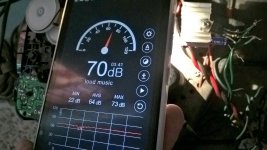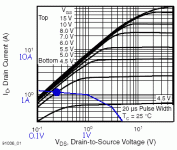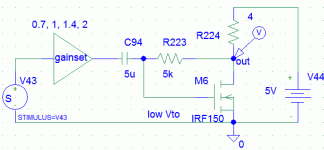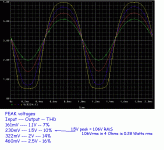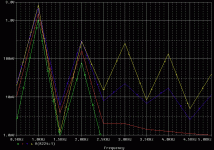I have one question though: how does one get 5v full rail voltage swing across the speaker without effect of circa 4v dropout voltage?
What drop-out voltage? Am I missing something? I think the collector can swing down to a few 100 mV, no?
Jan
I decided not to come back, but some things need to be straightened out.
This is what means to me, just this only, something I can measure, get an idea, can compare, with real life, as well as with standardised rreference.
So can my handful of customers.
It was made for sound, by sound, of sound.
Waited two daysand twelve pages gone.
So someone would ask for this, that never happened!
Even though I hinted this, with 'd' word.
I never had a c.r.o, by the way. So do my few clients, they're more interested how c major or d minors are coming.
Anyway, before commenting on further in this context, and making this 'troll' anymore healthier,
Kindly make sure, these letters really mean something to you..
dB, dBW, dBm, P (ref)
For a reference you can look here
Noise Comparisons
BTW, I didn't mark the yellow band )
Also here,
(Power) Db to Watt - OnlineConversion Forums
Don't know if this helps or augment the ambiguity
I could've mentioned this before, instead of much generalised mention of watt, that applies to mechanical to electrical to even humans, alike., but it unveiled very interesting remarks.
Inspite of much caustic comments, I got some good company too
Just for this comment, to see, how low my pretty little amp sounds, I stayed away from direct feeding my beloved aiwa or philips deck, and bought a non functioning pocket cassette player from flea market, repaired and here's the outcome.
70dB out of 5v, not a bad joke, eh?
Thank you !
This is what means to me, just this only, something I can measure, get an idea, can compare, with real life, as well as with standardised rreference.
So can my handful of customers.
It was made for sound, by sound, of sound.
Waited two daysand twelve pages gone.
So someone would ask for this, that never happened!
Even though I hinted this, with 'd' word.
I never had a c.r.o, by the way. So do my few clients, they're more interested how c major or d minors are coming.
Anyway, before commenting on further in this context, and making this 'troll' anymore healthier,
Kindly make sure, these letters really mean something to you..
dB, dBW, dBm, P (ref)
For a reference you can look here
Noise Comparisons
BTW, I didn't mark the yellow band )
Also here,
(Power) Db to Watt - OnlineConversion Forums
Don't know if this helps or augment the ambiguity

I could've mentioned this before, instead of much generalised mention of watt, that applies to mechanical to electrical to even humans, alike., but it unveiled very interesting remarks.
Inspite of much caustic comments, I got some good company too
And, Wollie, you're the only one to make this reference, nice for your overall appreciation )And if you want to analyze it or take it further, you're in good company.
Indr you have a great idea,for speakers at 96 dB
Wol
Just for this comment, to see, how low my pretty little amp sounds, I stayed away from direct feeding my beloved aiwa or philips deck, and bought a non functioning pocket cassette player from flea market, repaired and here's the outcome.
70dB out of 5v, not a bad joke, eh?
Thank you !
Attachments
Last edited:
70dB ... but then the studio monitoring levels are set to 83dB SPL, so there's still a way to go to get to the "proper" level to listen to how a CD or a track (or cassette) "it's supposed to sound".
Just like in photography, no one minds pesky specs, iso, aperture, film type after, say, one day max.
Ever tried to shoot a night concert with a f/1:5.6 lens and 200 iso film ? No ? I didnt think so. A proper photographer is constantly juggling those "pesky specs" in his head.
This thread is quite funny in a very odd way.

Last edited:
.. proper photographer...
.. thread is quite funny in a very odd way.
proper/ˈprɒpə/
adjective
1.denoting something that is truly what it is said or regarded to be; genuine.
2.of the required or correct type or form; suitable or appropriate.
3.belonging or relating exclusively or distinctively to; particular to.
4.in the natural colours.
5.(of a person) good-looking.
6.denoting a subset or subgroup that does not constitute the entire set or group, especially one that has more than one element.
adverb
satisfactorily or correctly
Which meaning would you attribute to a photographer?
For me, photography is all about chance, no staging
And, for the second,

Definition 1. and 2. seem adequate here. Definition 6. could be used too, to denote the subset of people who know how to use a camera, in opposition to all those able to "take pictures" with one.
And while there is indeed some luck involved in photography, knowing your pesky specs dramatically increases the odds of capturing that elusive moment. As in all art forms, a decent result only comes with training, training and even more training.
And while there is indeed some luck involved in photography, knowing your pesky specs dramatically increases the odds of capturing that elusive moment. As in all art forms, a decent result only comes with training, training and even more training.
..training, training and even more training.
Means, excessive training, ok, that's your vision, nice to know that,
I'm on a temporary infraction and was told to keep everything technically relevant here regarding audio.
Ok, but about excessive thing, I couldn't look away from your favourite quote about life, glowing just below of your comment 😀:
Thank you!
> circa 4v dropout voltage?
The D-S "drop out" of a MOSFET is a part-volt. (You may be thinking of source followers without over-the-rail gate drive.) See first image snipped from IRF640 data.
I simmed, using a variable-gain device to adjust 230mV drive signal from below to above full clipping in 3dB increments.
At low drive levels the thing has the expected 2nd harmonic distortion, "sweet". THD is essentially proportional to drive. At 1.5V peak output it reaches 10% THD, almost all 2nd. This is the customary place to rate a non-hi-fi amp, and figures as 0.280 Watts RMS. Past that it clips on the top and bottom, 3rd harmonic, "loud".
The simulation uses another (older) MOSFET which I tinkered to get an optimum Vto (the only way to set bias in this plan). The model used is very crude and not accurate at these relatively low currents. If someone has a better model which shows some higher level of higher harmonics, I'd believe it.
The D-S "drop out" of a MOSFET is a part-volt. (You may be thinking of source followers without over-the-rail gate drive.) See first image snipped from IRF640 data.
I simmed, using a variable-gain device to adjust 230mV drive signal from below to above full clipping in 3dB increments.
At low drive levels the thing has the expected 2nd harmonic distortion, "sweet". THD is essentially proportional to drive. At 1.5V peak output it reaches 10% THD, almost all 2nd. This is the customary place to rate a non-hi-fi amp, and figures as 0.280 Watts RMS. Past that it clips on the top and bottom, 3rd harmonic, "loud".
The simulation uses another (older) MOSFET which I tinkered to get an optimum Vto (the only way to set bias in this plan). The model used is very crude and not accurate at these relatively low currents. If someone has a better model which shows some higher level of higher harmonics, I'd believe it.
Attachments
Last edited:
i was about to try something similar, tho i were to send the output, through a capacitor, then a 70volt line output transfomer. found some 50uf oil caps, @200 volts, (nos, only $5) so it seemed i might get some bass.
then, i had to step out on a sort of mission. haven't been back, yet. only been, 10 years this month, so.....
then, i had to step out on a sort of mission. haven't been back, yet. only been, 10 years this month, so.....
- Status
- Not open for further replies.
- Home
- Amplifiers
- Solid State
- My amazing simplest classA amp with mosfet 640
